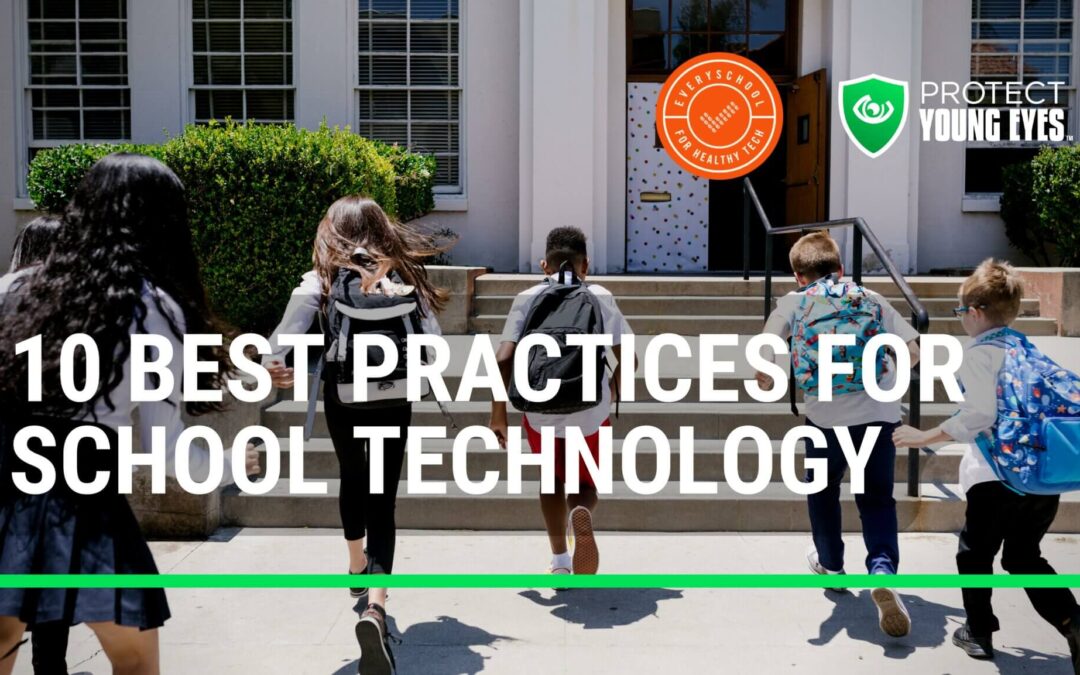This post was written in collaboration with Blythe Winslow, Founder of Everyschool, and Amy Tyson, Co-Founder and LISW. Both bring a research- and child-development-centric view to educational technology practices. Their experience is valuable and authoritative. Please share this information with your school leaders.
School-Issued Devices are Everywhere!
Many school districts have poured millions of dollars into devices – iPads, MacBooks, and Chromebooks. And because of COVID lockdowns, many students were forced to use school-issued technology for virtual school.
But few schools have a documented plan for using these powerful devices.
In many ways, this makes perfect sense. Innovation often begins with big, blind, enthusiastic leaps forward.
Think of the first cars – no rearview mirrors, airbags, or seatbelts. They were incredibly dangerous. But instead of just scrapping the invention, we looked for ways to make it safer for people.
That is the purpose of this post – to explore ways to recalibrate educational technology and look for ways to make it safer and more supportive to educational goals.
PYE has partnered with Everyschool to create this authoritative list of school technology best practices. You can learn more about their resources for districts and individual schools on their well-done website. The leadership at Everyschool, Blythe and Amy, are both moms, dedicated to helping schools establish a research-based approach to using technology in education that supports the well-being of students. We LOVE this.
If you’re a parent, how might you use this list?
- Compare the items below to what you know about your school and/or district.
- Discuss your thoughts with other parents to validate or correct your thinking.
- Request a meeting with your child’s principal to discuss gaps.
- Meet with the superintendent or head of school to discuss gaps.
- Consider presenting your ideas to the school board.
If you’re an educator, how might you use this list? That mostly depends on the culture of your school. Is leadership open to change? We (PYE) are happy to engage school leadership in discussions about how to move from where you are to where you might want to be (just leave a comment or contact us).
10 Best Practices for a District-wide Educational Technology Plan:
- Create a technology purpose statement.
- Use a classroom implementation model.
- Create age/grade learning outcomes or standards.
- Execute a balanced professional development plan.
- Use a student code of conduct or acceptable use policy.
- Implement and oversee a robust school network monitoring program.
- Implement an incident response system.
- Incorporate a digital wellness curriculum for students.
- Provide digital wellness education for families.
- Implement an “away for the day” personal device policy.
Now, more details and examples for each!
1. Create a technology purpose statement.
The goal here is to explain the “why” behind using school technology in one, simple sentence. This is the “sun” around which everything else in this list will orbit. It acts as guardrails for tactics and decisions. Spend some time here! Maybe have a session with teachers to elicit their input. Once you have a statement, market it broadly (e.g., website, Technology classroom, etc.)
Example: “Educational technology will be used when necessary to enhance learning, and show students how to be balanced and protected online.”
2. Use a classroom implementation model.
This is a more granular set of guiding principles that give teachers a common language for using technology across all subjects. Educators should be careful to use a non-corporate, research-based model, such as The EdTech Triangle from Everyschool. Other models (like SAMR) exist, but have not been updated to include contemporary EdTech and child development research.
Check this out: Everyschool EdTech Triangle
3. Create age/grade learning outcomes or standards.
These goals are mindful of child development and digital wellness research. States often issue these standards for public schools, which can be used as a starting point. Remember: many digital learning goals–such as coding or learning computational thinking–can be taught without a screen. A sound school technology plan doesn’t always need to include a device.
4. Execute a balanced professional development program.
A balanced professional development program for teachers and admins will not only expose them to new school technology trends, but also new EdTech, child development, and digital wellness research. A professional development program that is driven by corporate interest alone, or the idea that newer and more tech is always better, does not serve children or teachers best.
Check this out: Schedule a PYE professional development half- or full-day session!
5. Use a student code of conduct or acceptable use policy.
Clearly state when and how students are allowed to use school-issued devices. The policies should be clearly written in simple terms so as to be understood by all grade levels. Specific types of rule breaking, such as knowingly accessing porn on school grounds, include a consequence protocol.
Check this out: PYE, please send me school policy examples!
6. Implement and oversee a robust school network monitoring system.
School-network monitoring is essential to not only protect student well-being, but also to protect the school from situations where children are carrying out digital harms on other children while using school-issued devices. Enterprise-wide monitoring systems like Securly, GoGuardian, and Bark for Schools are popular. Key: not only do schools need to have these systems in place, but they must be monitored by school staff who notice and follow procedures when incidents occur.
Check this out: Bark for Schools
7. Implement an incident response system.
This system should allow for parents, teachers, and students to report online bullying, digital safety issues, and other incidents easily and without shame. Remember – students are your best first responders. They almost always know something “doesn’t quite feel right” before school leaders or law enforcement.
8. Incorporate a digital wellness curriculum for students.
Digital wellness is defined as an intentional state of engagement with the digital world that does not interfere—but instead supports—mental, physical, and social health. This can look like a digital wellness month or the use of a more concerted internal curriculum. The goal is to not only help students learn digital citizenship, but to also see how their own tech use might help or hinder their personal growth and impact others around them.
Check this out: Learn more about the PYE Be Tech Ready curriculum
9. Provide digital wellness education for parents.
When parents understand digital wellness and form their children accordingly, school communities thrive, teachers are impacted positively, and administrators are less burdened. As such, offering digital wellness resources and support for parents makes sense for every school. Resources might come in the form of a digital wellness newsletter or speaker, or discussion sessions via the PTA or PTO. If parents are interested in educating and supporting themselves through school-based digital wellness groups, those are easily formed and supported by school communities (see Everyschool.org’s POE groups).
Check these out:
Learn more about Parents of Everyschool groups!
Learn more about PYE parent talks!
10. Implement a limited use personal device policy.
Although it can feel political to do so, research and common sense have mostly weighed in on this subject: restricting cell phones during instructional time raises grades and is supported heavily by most parents and teachers*. Stakeholders–including students–in districts who have implemented effective “away for the day” policies have reported notably positive results such as less FOMO and increased focus and face-to-face connection with peers.
Check this out: Forest Hills School Removes Smartphones
*A minority of parents push back on removing personal devices because of the threat of school violence. But experts still agree that the risks outweigh the benefits.
School technology can be used for so much good! And incorporating these ten school technology best practices into your District or school will maximize the benefits of instructional devices while minimizing their downsides.
Ultimately, we want learners who are as good at critical thinking as they are at Googling, as adept at interacting socially as they are at finding stellar online resources for an essay, and who can empathize, focus, and work collaboratively with others.
Are You Ready for an Updated Tech Curriculum?
Be Tech Ready from Protect Young Eyes is a faith-based, digital wellness curriculum, built on learning standards, and ready for you! It uses flexible lessons that can be easily downloaded and customized by your teachers.
- Satisfies multiple Catholic Safe Environments requirements! We’ve mapped our content to multiple compliance programs (e.g., VIRTUS).
- Written by ministry leaders with over 40 years of combined Catholic and Protestant experience.
- Mapped to International Society for Technology in Education teaching standards.
- Includes 20 videos created with teens and young adults.
- Bilingual at-home content keeps the learning going with parents!





